|
|
 |
Fiche d'espèce de Copépode |
|
|
Calanoida ( Ordre ) |
|
|
|
Clausocalanoidea ( Superfamille ) |
|
|
|
Aetideidae ( Famille ) |
|
|
|
Euchirella ( Genre ) |
|
|
| |
Euchirella splendens Vervoort, 1963 (F,M) | |
| | | | | | | Syn.: | ? Euchirella messinensis : T. Scott, 1894 b (p.45, figs.M);
no E. splendens (M) : Grice, 1969 a (p.453, figs.M) | | | | Ref.: | | | Vervoort, 1963 b (p.138, Descr.F, figs.F, Rem.); Vaupel Klein, 1972 (p.502, 505, fig.F); Park, 1975 (p.296, figs.M); 1976 a (p.118, figs.F,M); Bradford & Jillett, 1980 (p.33); Vaupel Klein, 1980 (p.152); 1984 a (p.47, Table II: characters); Markhaseva, 1996 (p.169, figs.F,M); Bradford-Grieve & al., 1999 (p.879, 921, figs.F,M); Vives & Shmeleva, 2007 (p.572, figs.F,M, Rem.) |  issued from : E.L. Markhaseva in Proc. Zool. Inst. RAN, St. Petersburg, 1996, 268. [p.171, Fig.132 ]. Female (specimen from N Atlant.). Ce: forehead (lateral). Nota: Genital segment on the right posteriorly with projection of slightly varying shape. A1 reaching urosomal segment 4. Endopod od A2 about 1/4 of exopod length; endopodal segment 2 with 4 setae on internal lobe and 5 setae on external lobe.
|
 issued from : T. Park in Contr. Mar. Sci., 1976, 20. [p.119, Fig.9]. Female: a, forehead (lateral); b, c, posterior part of metasome and urosome of two different specimens (dorsal); d, idem (lateral); e, A2; f, basipod of fourth leg (posterior). Male: g, forehead (lateral); h, fifth pair of legs (anterior); i, first exopodal segment of right fifth leg (anterior); j, distal part of left fifth leg (anterior); k, idem (posterior).
|
 issued from : T. Park in Crustaceana, 1975, 28 (3). [p.296, Fig.4]. Male (from Gulf of Mexico): A, habitus (dorsal); B, forehead (lateral); C, P5 (anterior); D, distal part of left P5 (anterior); E, idem (posterior). Nota male after Markhaseva (1996, p.170): Cephalon without crest. Rostrum better developed than in female.Left P5 with exopodal segment 1 reaching the distal end of right basipodite, endopod of right P5 with 4 teeth-like projections along internal margin, third projection of exopodal segment 1 is at the level of 1st projection on endopod (with curved top).
|
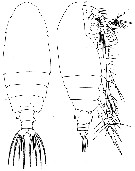 issued from : W. Vervoort in Atlantide Report., 1963, 7. [p.139, Fig.13]. Female (from off Ghana): a-b, habitus (dorsal and lateral, respectively) (x24). Nota: The length of urosome is contained 4 times in that of the cephalothorax. Rostrum strong and slender, one-pointed and directed downwards. The 4th and 5th thoracic somites completely fused, the line of fusion is only visible in dorsal aspect on the back. The corners of the last thoracic segment carrying a number of hairs. The 1st and 2nd urosomal somites are fused to form the genital complex (double-somite); there is a curious, more or less bilobated sac-shaped protuberance on the right side. Proportional lengths of urosomal segments and caudal rami 54:15:13:5:13 = 100.
|
 issued from : W. Vervoort in Atlantide Report., 1963, 7. [p.140, Fig.14]. Female: a-c, posterior partcephalothorax and urosome (lateral right side, dorsal and lateral left side) (x45). Nota: The large caudal rami and the anal segment are partly coalescent, the line which separates both parts is distinct laterally; the anal plate is small and broadly rounded. Each caudal ramus has 4 strong, densely plumose setae, in addition 1 short and strong spine at the external corner and 1 geniculate plumose seta at the internal corner; the inner surface of the caudal rami is haired.
|
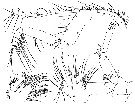 issued from : W. Vervoort in Atlantide Report., 1963, 7. [p.142, Fig.15]. Female: a, A1 (x304); b, A2; c, Mx1; d, Mx2; e, Mxp. (b-e: x88). Nota: A1 23-segmented ( 8th and 9th, 24th and 25 th segments fused). A2 with a much reduced endopodite. Md with a strong development of the praecoxa (mandibular blade, gnathobase) with a number of small but sharp teeth, the cranial portion of each edge has a semicircular, knife-sharp, chitinized structure, those of the two sides fitting together to form a remarkable scraping or cutting structure; coxa and basis of the palp are fused to form a trapezoid segment without setae; endopodite 2-segmented; exopodite 5-segmented. Mxi with praecoxal arthrite strongly produced and has 10 strong, tooth-like setae, in addition there are 3 smaller setae; the coxa indistinctly separated from the praecoxa, the coxal endite is lengthened with 4 strong, spiniform setae; epipodite scarcely elevated with 8 setae; basipodite undivided and lengthened, the endite is only slightly smaller than that of the coxa, it carries 1 strong seta, 2 small setae and a blunt tooth; ; there are 3 setae at the end of the basipodite; endopodite 3-segmented, the number of setae being 1, 1 and 2 respectively; exopodite small with 11 fine setae. Mx2 with praecoxa and coxa fused, there are 2 praecoxal and 2 coxal endites, each with 3 setae, one seta on the 2nd coxal endite very strong and coalescent with the endite; there is only 1 basal endite with 1 very strong seta and 2 smaller setae; endopodite 3-segmented with 1, 1 and 4 setae respectively.
|
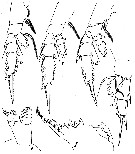 issued from : W. Vervoort in Atlantide Report., 1963, 7. [p.143, Fig.16]. Female: a-d, P1 to P4; e, Md (mandibular palp); f, Md (cutting edge). (a-e: x88; b-d:x55; f: x220). Nota: P5 absent.
|
 issued from : J.C. von Vaupel Klein in Crustaceana, Supplt 9, Studies on Copepoda, III, 1984. [p.65, Fig.6 k]. Euchirella slendens: a, Setal armature of endopodte 2+3 of A2. Conditions are expressed are expressed in formulae as follows: number of setae in regular row on proximal lobe / relative development of seta in position no. 9 on this lobe / number of setae in approximately linear row on terminal lobe / relative development of appendicular seta no. 7 and its supporting pedestral (absent, vestigial, moderate or well developed: see Table I, p.87 and Table II, p.93). Upper and lower lobes = proximal and terminal lobes, rspectively (details of right appendage shown in medial aspect. Scale bar = 0.133 mm. Nota: Condition 4/0/5/1 in the messinensis-group.
|
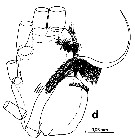 Issued from : J.C. von Vaupel-Klein in Zool. Meded., Leiden, 19972, 47 (41). [p.509, Fig.4, d]. Female (from 8°13'S, 2°54'E): d, endopodite of right P1 (anterior view). Nota: 'organ of Vaupel Klein' (see explanation to Euchirella curticauda.)
|
 Euchirella splendens Euchirella splendens female: 1 - Crest absent. 2 - Genital segment asymmetrical. 3 - Genital segment with large projection on the right side (dorsal view), left side with slightly sweeling . 4 - Projection on the right of genital segment abruptly prominent (dorsal view). Coxopodite of P4 with 2-3 spines. 5 - Projection on genital segment is not ear-like, arranged in its posterior half.
|
 Issued from : J.C. von Vaupel Klein in Crustaceana, Supplt 9, Studies on Copepoda, III, 1984. [p.70, Fig.10, b]. Euchirella rostrata: Structure and setal complement on the outer lobe of basis 1 of Mx1 (detail of left appendage in posterior aspect). complement of 8 setae, the 5th one from proximal being reduced in length and in thickness.
|
 Issued from : J.C. von Vaupel Klein in Crustaceana, (Supplement) 9, 1984. [p.93, Table II]. Euchirella splendens Female: Datamatrix stating observed states of characters from Table I (p.87-90) presently examined; nos. refer to the input nos. used in Table I (see to the family Aetideidae).
|
 Issued from : J.C. von Vaupel Klein in Crustaceana, (Supplement) 9, 1984. [p.94, Table I (cont' d)I]. Euchirella splendens Female: Datamatrix staring observed states of characters from Table I (p.87-90) presently examined; nos. refer to the input nos. used in Table I (see to the family Aetideidae).
|
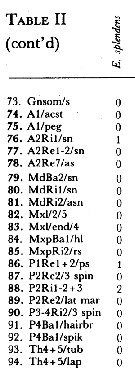 Issued from : J.C. von Vaupel Klein in Crustaceana, (Supplement) 9, 1984. [p.95, Table II (cont' d]. Datamatrix stating observed states of characters from Table I (p.87-90) presently examined; nos. refer to the input nos. used in Table I (see to the family Aetideidae).
| | | | | Ref. compl.: | | | Park, 1970 (p.475); Bainbridge, 1972 (p.61, Appendix Table III: occurrence); Vives, 1982 (p.291); Brenning, 1983 (p.3, 5, spatial distribution, T-S diagram, Rem.); 1985 a (p.28, Table 2); Lozano Soldevilla & al., 1988 (p.58); Suarez & al., 1990 (tab.2); Suarez & Gasca, 1991 (tab.2); Suarez, 1992 (App.1); Suarez-Morales & Gasca, 1998 a (p108); Mauchline, 1998 (tab.30); Lapernat, 2000 (tabl.3, 4); Schnack-Schiel & al., 2010 (p.2064, Table 2: E Atlantic subtropical/tropical); Medellin-Mora & Navas S., 2010 (p.265, Tab. 2); Teuber & al., 2013 (p.1, Table 2, 3, respiration rates, enzyme activity); Schukat & al., 2013 (p.1, Table 1, 2, fig.2, respiration, ingestion); Bode & al., 2015 (p.268, Table 1, chemical components, trophic level, geographic zone); Bode & al., 2018 (p.840, Table 1, respiration & ingestion rates) | | | | NZ: | 5 | | |
|
Carte de distribution de Euchirella splendens par zones géographiques
|
| | | 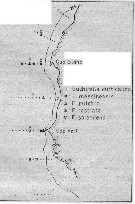 issued from : U. Brenning in Wiss. Z. Wilhelm-Pieck-Univ. Rostock - 32. Jahrgang 1983. Mat.-nat. wiss. Reihe, 5. [p.1, Fig.1]. issued from : U. Brenning in Wiss. Z. Wilhelm-Pieck-Univ. Rostock - 32. Jahrgang 1983. Mat.-nat. wiss. Reihe, 5. [p.1, Fig.1].
Spatial distribution for Euchirella curticauda, E. messinensis, E. pulchra, E. rostrata, E. splendens from 8° S - 26° N; 16°- 20° W. |
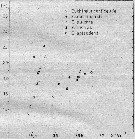 issued from : U. Brenning in Wiss. Z. Wilhelm-Pieck-Univ. Rostock - 32. Jahrgang 1983. Mat.-nat. wiss. Reihe, 5. [p.3, Fig.3]. issued from : U. Brenning in Wiss. Z. Wilhelm-Pieck-Univ. Rostock - 32. Jahrgang 1983. Mat.-nat. wiss. Reihe, 5. [p.3, Fig.3].
T-S Diagram for Euchirella curticauda, E. messinensis, E. pulchra, E. rostrata, E. splendens from 8° S - 26° N; 16°- 20° W. |
 Issued from : M. Bode, R. Koppelmann, L. Teuber, W. Hagen & H. Auel inGlobal Biogeochemical Cycles, 2018, 32. [p.844, Table 1). Issued from : M. Bode, R. Koppelmann, L. Teuber, W. Hagen & H. Auel inGlobal Biogeochemical Cycles, 2018, 32. [p.844, Table 1).
Cf. explanations of these measures in Calanoides natalis from the same authors.
Compare with Euchirella rostrata, E. pulchra, E. curticauda. |
| | | | Loc: | | | off Angola, Atlant. (SE tropical), Congo, G. of Guinea, off Lagos, off Senegal, off Mauritania, off Morocco-Mauritania, off Amazon, Caribbean Sea, Caribbean Colombia, Gulf of Mexico.
Type locality: Gulf of Guinea. | | | | N: | 22 | | | | Lg.: | | | (14) F: 5,05-4,2; (37) F: 5,05-3,88; M: 3,76-3,4; (235) F: 4,83-3,88; M: 3,76-3,4; (236) M: 3,76-3,6; (242) F: 5,2-3,9; (1109) F: 4,33-4,95; (1257) F: 4,4-5,2; {F: 3,88-5,20; M: 3,40-3,76}
The mean female size is 4.527 mm (n = 10; SD = 0.5423), and the mean male size is 3.656 mm. The size ratio (male : female) is 0.81. | | | | Rem.: | épi-bathypélagique.
Voir aussi les remarques en anglais | | | Dernière mise à jour : 22/02/2021 | |
|
|
 Toute utilisation de ce site pour une publication sera mentionnée avec la référence suivante : Toute utilisation de ce site pour une publication sera mentionnée avec la référence suivante :
Razouls C., Desreumaux N., Kouwenberg J. et de Bovée F., 2005-2025. - Biodiversité des Copépodes planctoniques marins (morphologie, répartition géographique et données biologiques). Sorbonne Université, CNRS. Disponible sur http://copepodes.obs-banyuls.fr [Accédé le 13 juillet 2025] © copyright 2005-2025 Sorbonne Université, CNRS
|
|
 |
 |


















